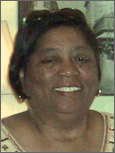
Information is the key for getting a handle on high blood pressure
High blood pressure is one of the most common medical problems. It is also a condition too many people don’t take seriously, often because people with high blood pressure tend not to suffer symptoms.
Annie Randolph, of Decatur, Georgia, is one of 65 million Americans living with high blood pressure. Annie was diagnosed with the condition by her doctor during a checkup in 1991, when she was in her mid-40s. But it’s only been within the last 5 years that Annie has gotten a handle on her high blood pressure—because she learned more about it and how to treat it.
But before she did, she found herself in the hospital a couple of times and very nearly had a stroke.
When Annie was first diagnosed, she was not told that blood pressure is the stress that blood puts on the inside walls of the arteries (or blood vessels) as it flows through the body. And no one told her that high blood pressure is called the “silent killer.”
Because she didn’t know much about high blood pressure or have any obvious symptoms, Annie didn’t pay her medical condition much attention. “I was going through a very stressful time when I was first told I had high blood pressure,” Annie says, assuming her blood pressure would go back to normal when she wasn’t under so much stress.
“I didn’t take my doctor seriously because I did not know what the implications were,” Annie says.
Been diagnosed with high blood pressure or know someone who has? To find out more about your treatment options, the Agency for Healthcare Research and Quality offers a helpful, free consumer guide, called Comparing Two Kinds of Blood Pressure Pills: ACEIs and ARBs.
What Annie didn’t know then was that high blood pressure, when left untreated, can cause people to have strokes, heart attacks, and problems with their kidneys.
And she had some close calls.
One morning when she was getting ready for work she didn’t feel well. So she went to her doctor instead of work. Annie’s doctor told her to go to the hospital. “I was placed in intensive care,” she says, “I was right at stroke level.”
Some people can lower their blood pressure by changing to healthier habits. Losing weight, eating healthy, and being active can help. Most people also need medication to bring their blood pressure under control.
When she was released from the hospital, her doctor “started me on a diuretic (water pill) and some sort of blood pressure pill,” she says.
But, she admits, she didn’t take her medication properly. She gained weight and stopped taking the pills. Her doctor tried different medicines and combinations, but I “paid no mind,” says Annie.
It was only after she was hospitalized a second time that “I started taking my condition seriously,” she says.
Her second hospitalization also occurred at a time when information on medical conditions became more prevalent. “We didn’t really have much information in the past. Today, information is really easy for consumers to find.”
Annie was able to learn more about her high blood pressure and treatment options from the Internet, medical magazines, and her sister-in-law, who was a pharmaceutical sales representative. She has also made a point of talking to different people, and now asks her doctor more questions.
“I tried at least four or five medicines for high blood pressure and different dosages,” she says, adding that her doctor “also did a combination of different drugs.”
After working with her doctor, Annie found a combination of medicines that were right for her. She also exercises, knowing that will help her blood pressure.
She figures, “If we’d had this much information in the past, I don’t think people would be as unhealthy as they are today.”
Read other patient stories
Gwen Rodenberger
A diabetes diagnosis was a wake-up call to self-proclaimed “couch slug” Gwen Rodenberger, who wanted to find out the best ways she could improve her life. Read more.
Rick Thornton
At 47, Rick Thornton was diagnosed with prostate cancer. An engineer by training, Rick weighed the angles of different options to treat his cancer. Carefully considering his choices helped Rick to conclude which treatment was right for him. Read more.
Jennifer Jaff
Thirty-five years ago, Jennifer Jaff was diagnosed with Crohn’s Disease. It has only been in the last 8 years that her quality of life has improved. What made the difference? Making a shared treatment decision with her doctor after exploring all her options. Read more.
Steve Thurner
After getting diagnosed with type 2 diabetes, Steve Thurner delayed learning anything more about his disease or treatment alternatives. But his life improved when he finally took the time to educate himself and compare his options. Read more.
Marti Denk
Marti Denk considered different treatment options for breast cancer after her doctor gave her homework—to talk to other patients and do some reading. Marti says that advice led her to being perfectly fine today. Read more.
Julia Hallisy
Over a decade of helping her young daughter deal with eye cancer, Julia Hallisy’s determination to understand treatment options led to an improved quality of life and ultimately less pain for her child. Read more.


 E-mail Updates
E-mail Updates